Rewire Pt. 3: Escape from Hollywood
No Get Out of Jail Free Card
Starting a new life is exciting, damn exciting. The thrill of “what’s next?” is why you do it in the first place. There’s just one little, tiny problem: you have to extract yourself from the here and now. And that is one of the toughest things we’ve ever done on every level; logistically, financially, and emotionally. In our case, extraction meant remodeling our house, sorting through sixteen years of stuff to determine what makes the cut, selling our house, and moving out. Sounds simple, but it took us every bit of eighteen months. The following is our tale of how you leave it all behind.
Letting Go is Hard to Do
No one can live in one place for 16 years and not have tons of stuff, memories, and connections to sort through. Since we didn’t know where we were headed, we were forced to take an even harder look at what we needed, what we wanted, and what we could jettison. This process caused a ripple through every aspect of our life, forcing us to ask, “should we keep it?” for everything (including each other:). Nothing was bought without that in the back of our mind. No closets were opened without silently thinking, “Damn, another batch of stuff to go through.”
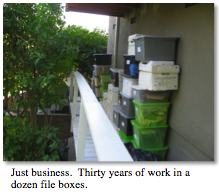 For me, it was a business process. I had a career of 30+ years to review. Did I really need that Procter & Gamble brand presentation from ‘83? Sure it was good, but was it that good? Karen assured me it wasn’t:). I went through dozens and dozens of file boxes reliving my career. I’d catch myself reading memos from businesses past and remembering all the good times and work I’d done. Before I could say, “stop that, you’re wasting time!” I’d been sitting in the basement for two hours just reading stuff. Somehow I got the files down to less than a dozen in number, put them in new plastic boxes, and went on to the next thing.
For me, it was a business process. I had a career of 30+ years to review. Did I really need that Procter & Gamble brand presentation from ‘83? Sure it was good, but was it that good? Karen assured me it wasn’t:). I went through dozens and dozens of file boxes reliving my career. I’d catch myself reading memos from businesses past and remembering all the good times and work I’d done. Before I could say, “stop that, you’re wasting time!” I’d been sitting in the basement for two hours just reading stuff. Somehow I got the files down to less than a dozen in number, put them in new plastic boxes, and went on to the next thing.
I applied the same 20% emotional/80% logical approach to all the stuff in my purview. Garage tools, done. My clothes, done. Motorcycle stuff, done. Car stuff, done. Electronics, done.
Karen was operating in a different world, of course. She, not surprisingly, applied the reverse approach: 80% emotional/20% logical. She wasn’t reviewing old bu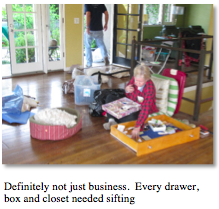 siness files, but memories, mementos, and everyday items that had a use. She couldn’t open a drawer or look into a closet without traveling down memory lane and trying to separate great memories from great practicality. Moreover, she was charged with the responsibility of setting up our new house, wherever that might be, as quickly and efficiently as practical. In Karen’s world, everything has a value to be weighed.
siness files, but memories, mementos, and everyday items that had a use. She couldn’t open a drawer or look into a closet without traveling down memory lane and trying to separate great memories from great practicality. Moreover, she was charged with the responsibility of setting up our new house, wherever that might be, as quickly and efficiently as practical. In Karen’s world, everything has a value to be weighed.
We developed a number of techniques to get us through the sifting and packing process. We spent enough money on plastic storage containers (Preferably with clear sides so you could see what’s insid e. We’re probably the only couple who can speak with authority on plastic container brands:) to raise DuPont’s quarterly earnings. To counter this expenditure, Karen tried selling things in every which way she could think of: Amazon, eBay, Craig’s List, and local flea markets. We spent long periods of time in different parts of the house so as not to get in each other’s way. Friends stepped in whenever there was an impending disaster. What we didn’t sell, we tried to give away: friends, neighbors, charities, shelters and our horde of Mexican workers. While all of this was going on, of course, we were either remodeling the house or trying to sell it. We lived in a constant state of chaos and tension between the old and new. Somehow we lived through it.
e. We’re probably the only couple who can speak with authority on plastic container brands:) to raise DuPont’s quarterly earnings. To counter this expenditure, Karen tried selling things in every which way she could think of: Amazon, eBay, Craig’s List, and local flea markets. We spent long periods of time in different parts of the house so as not to get in each other’s way. Friends stepped in whenever there was an impending disaster. What we didn’t sell, we tried to give away: friends, neighbors, charities, shelters and our horde of Mexican workers. While all of this was going on, of course, we were either remodeling the house or trying to sell it. We lived in a constant state of chaos and tension between the old and new. Somehow we lived through it.
Selling Through a Recession
Most people thought we were nuts to put our house on the market during the worst recession in our lifetime, particularly one that was led by a housing meltdown. My view was different. While our house had certainly suffered some depreciation (whose hasn’t?), I was convinced the market for houses like ours wasn’t going to get better in just a matter of months, or years for that matter. It wasn’t just the sloooooowwwwllllyyyy improving economy, too man y Baby Boomers on five-year adjustable mortgages were going to reboot in the next few years, adding a ton of inventory waiting to go on the market. Finally, the temporary tax incentives for first time buyers were scheduled to end soon.
y Baby Boomers on five-year adjustable mortgages were going to reboot in the next few years, adding a ton of inventory waiting to go on the market. Finally, the temporary tax incentives for first time buyers were scheduled to end soon.
On the positive side, we had a great house that wasn’t going to be easily duplicated. Comps in our neighborhood were notoriously hard to rationalize. For the right buyer – two adults, no kids — our house was a gem.
Most importantly, we didn’t want to wait another five years to get on with The Next Great Thing. We decided to push the Sell Button, knowing that we wouldn’t be selling at the top of the market, but pretty damn sure we weren’t selling at the bottom either.
It’s difficult to pick what the worst experience was: remodeling, selling or moving each presents its own particular form of torture. Like everyone else, our home was our biggest financial asset, so pricing was serious business. On top of the financial stress, having open houses, brokers opens and private showings every couple of days would test Martha Stewart’s penchant for cleanliness. Being ready to “show” the house at a moment’s notice essentially stopped us from “living” in our home for the final four months. We took to sleeping outside so we didn’t have to make up the bed before each showing.
We started the selling process all bright and bushy-tailed. For each Open, we’d happily clean the house for two days and then hide down the street and watch people come in. We even camped across the canyon with binoculars so we could watch each prospective buyer as they toured the house. We kept tallies, tried to remember faces and counted the number of times people would come back (many, many people came more than 3X and never made an offer).
After 30 days, the first lingering doubts crept in. After 60 days I was worried and started to get angry at our brokers. We took all low-ball offers personally. After 90 days we had a Come-To-Jesus meeting with our brokers who assured us we would move the merchandise if we’d do a price reduction. We tried every sales idea we could think of from putting an ad in the entertainment trade rag to holding mid-week cocktail parties for brokers.
And then one evening our broker said a perspective buyer wanted to meet us. The Buyer, an adult couple with no children, wanted a personal tour of the house, wanted to know its history, and wanted to convince us they were the right buyers for our home. What? They wanted to convince us? Two weeks later and we had accepted their offer.
Of course, any one who has sold/bought a house in California knows The Offer is just the beginning of an agonizing process called Escrow. First out of the box are the countless inspections that the Buyer will require, everything from pests to earthquake experts to electricians to sewer men. Each of these inspectors will find something that is significantly wrong with the property and supply a hugely inflated estimate of costs to repair. Buyer and Seller then negotiate the particulars, each not wanting to screw the deal, but not wanting to be screwed either. These inspections take place over weeks and weeks and involve tens of thousands of dollars in potential repairs. Along the way, the Buyer is supposedly meeting his/her various hurdles like getting financing. I learned the hard way through our 60 days of hell (Escrow) that it’s never over until the checks in the bank and its cleared.
How’d it work out? Here are the facts: (1) We listed the house on November 2 and accepted an offer on March 3. We had multiple offers; (2) We got 92% of our original asking price and 99% of the price we quietly wanted; (3) We held Open Houses every weekend except on Christmas/New Years for four plus months; (4) We moved our final things out of our home of sixteen years on April 29 2010.
All’s well that ends well, I guess. Here’s what I’ve learned about selling a house during the worst recession in our lifetime:
- Do your homework. You need to look at every potential house for sale in a two mile radius to get a good, realistic, yet full-valued price on your home. Use these competitive scanning trips to informally interview potential real estate brokers. Are they articulating the pluses of the property in a way that isn’t annoying? Are they knowledgeable about the neighborhood? How are their sales materials? Did they have a realistic perspective on pricing? When we were done with this process, we had a pretty good idea of what we thought the house was worth and we’d identified four or five potential brokers

- The most important thing is to pick the right broker: We interviewed five potential candidates, each coming through the house and giving us their pitch. For me, the keys are personal/passionate attachment to the house, the quality of the sales materials, the horsepower to market the property far and wide, and their desire/ability to do whatever it takes to make the right deal happen. I ignored whether they knew the neighborhood (that’s what MLS are for) and instead concentrated on whether they knew the right kind of buyer for our house.
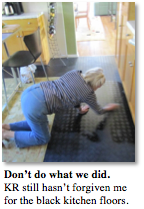
- Stage, stage and stage! Our brokers made critical suggestions in how to better arrange the furniture and Karen was a genius in making the place look and smell wonderful. We’d spend $100 on flowers for each open or showing, Karen would cook apples and cinnamon and then secrete them everywhere. Candles and lighting were equally important, to be adjusted to the time of the showing (for sunsets we brought out the flame torches and set them alight in the yard and on the decks).
- Don’t take it personally. If I had one thing to change, I wish we’d taken the emotion out of the process. It would have been a whole lot less stressful. It’s just business, in which the buyer is looking to buy your house at the lowest price possible and you’re trying to get the best deal possible. Low ball offers? Ignore them and move on. Outrageous demands from an inspection report? Offer to do the repair yourself.
Innovations in Moving Techniques
The days of backing up the Mayflower van to the driveway and moving are over. OK, that was never an option for us anyway as we had no address for the Mayflower to go to! We couldn’t possibly rent a moving truck and move stuff into a storage facility either as we needed every day of our 60 day escrow to organize/toss/pack our 16 years of stuff. No, we needed a new solution — another Plan B!
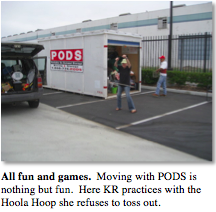 Then my friend Sam suggested that I look into something called PODS (Personal On Demand Storage http://www.pods.com/ ), in which they bring a moveable storage container to your doorstep for as long as you need it, come and pick it up when its full, and put it away in storage when you’re done. When you want to get some your stuff, you make an appointment and go to one of their warehouses. They’ll even move it cross country for you. This system works wonders.
Then my friend Sam suggested that I look into something called PODS (Personal On Demand Storage http://www.pods.com/ ), in which they bring a moveable storage container to your doorstep for as long as you need it, come and pick it up when its full, and put it away in storage when you’re done. When you want to get some your stuff, you make an appointment and go to one of their warehouses. They’ll even move it cross country for you. This system works wonders.
Our next moving innovation was taking advantage of the vast immigrant work force hanging out at Home Depots across Los Angeles. Whenever I needed to pack, store, trash, organize, clean or whatever, I’d drive down to our local Home Depot and pack the Jeep full of $10/hr guys. I was such a good employer that guys would start running toward the car as soon as I entered the parking lot. If I needed a lot of stuff moved, I hired the young and strong. If we were going to pack the POD with more stuff, I hired the guys who were good packers and knot tiers. KR and I got to know a bunch of guys by name during our 60 day Escrow period. Most everyone of these guys were hard working, incredibly appreciative of the work, and would didn’t stop working until I drove them back down the hill to HD at the end of the day.
Our move was a mash up between high technology, a ready and inexpensive work force, and a fluid organizing/sifting/packing and storing process. I expect to hear from Harvard Business School for a case study request any day now.


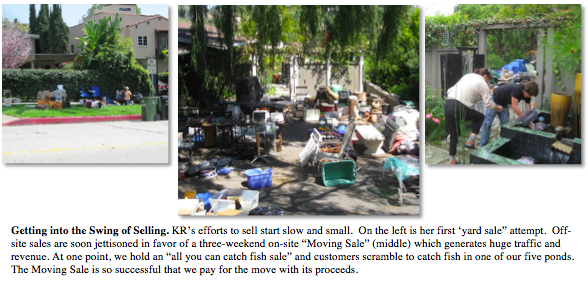



Leave a Reply
Want to join the discussion?Feel free to contribute!